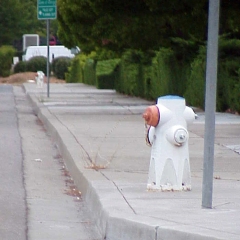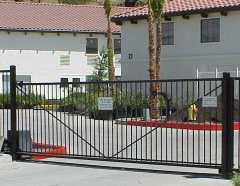© 2000 Capt. Willis Lamm, Water Supply Officer, Moraga-Orinda (CA) Fire DistrictBackground Criteria Storage Distribution Hyd. Design Placement Installation Codes & Markings Applications Codes & Standards
|
| FIRE HYDRANT PLACEMENT |
|
"Standard" Hydrant Spacing
Standard practice involving hydrant placement is to install hydrants every 500 ft. For practical application, this standard is a guideline and minor deviations in this spacing may be appropriate. When determining locations to place fire hydrants, consideration should be given to accessibility, obstructions, proximety to structures protected, driveway entrances and other circumstances where adjustments to a specific hydrant's location would be warranted. In jurisdictions where all fire engines are equipped with 4 in. (100mm) or greater large diameter hose (LDH), the maximum spacing between hydrants can be equal to the smallest in-service compliment of LDH carried. For example, if the smallest compliment of LDH carried on any engine is 900 ft., it is acceptable to increase hydrant spacing, where necessary, to 900 ft. This allowance may provide considerable cost savings. |
Regular placement in a business district
|
|
For reasons of public safety, it should not be the objective of hydrant system engineers to attempt to maximize the spacing between fire hydrants. Especially in locations where structures are set back from public roadways, some consideration should be given to ensure that all structures are within "reach" of appropriate hydrants utilizing standard hose lays. To so do may require hydrants to be strategically placed at driveway entrances or that laterals be run from street mains into complexes so that hydrants will be in reasonable proximety to the structures being protected. "Risk Based" and Practical Hydrant Placement There also needs to be a sufficient number of hydrants to provide the required fire flow for large or high hazard structures. The combined flows of two or more hydrants may be required to meet these fire flows and each of these hydrants must be within 500 ft. or LDH hose lay distance of the structure, whichever is greater. Another consideration is preservation of vehicle access. If possible, hydrants should be placed in locations where engines and hose lays connected to them will not block critical accessways. Preservation of hydrant access is an important issue. A hydrant isn't useful if when the project is completed, it is isolated by a fence, gate or other obstruction which makes it impractical to utilize to protect one or more of the structures for which it was intended. Walls, gates, fences and other obstructions should appear on preliminary development plans and if these improvements affect the use of proposed hydrants, adjustments to the hydrant locations or placement of additional hydrants should be considered. Finally, whenver possible hydrants should not be placed so close to structures that they cannot be used if the structures are heavily involved with fire. In circumstances where structures are built right next to the roadway, the 500 ft. rule should be employed since a hydrant located a safe distance from the involved structure may have to be utilized. Before plotting the specific locations for new fire hydrants, the fire chief or his/her designate must be consulted to ensure that all of the operational and practical issues have been considered prior to final placement of hydrants.
| |
| Continue to Part 6 |
Return to Part 4
Return to Information Section
Return to Water Supply Page
Background Criteria Storage Distribution Hyd. Design Placement Installation Codes & Markings Applications Codes & Standards
|

